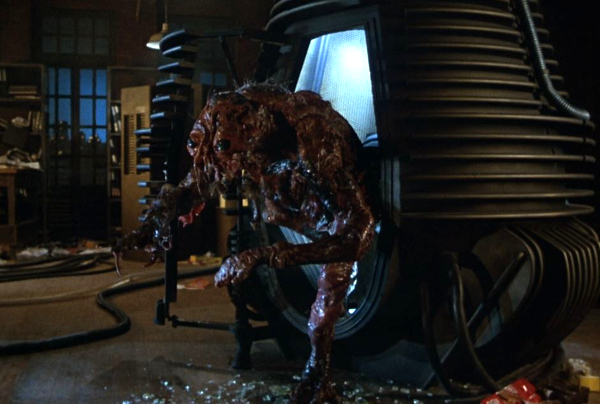I’ve asked the question; What is Acid Horror? But now I want to explore it, prod it like a surgeon with a knife - pick apart the bits and pieces that make it up. Join me for this retrospective series of short essays as we explore the media which inspired the term ‘Acid Horror,’ and more importantly… what the subgenre can teach us about ourselves.
_________________________________________________________
“You’re afraid to be destroyed and recreated, aren’t you? You can’t penetrate beyond society’s sick, gray, fear of the flesh. Drink deep, or taste not, the plasma spring! Y’see what I’m saying?”
- Seth Brundle.
What does it mean to deteriorate? To un-become? To realize that you are not one thing, but many; a biological collective of teeming, twisting matter that used to be a person?
As long as mankind has had age, disease, and death, we have watched each other dissolve in one way or another. In some ways, it is the most universal human experience, and yet we flinch rather than look it in the face. We are terrified of a life with consequences, one with a period at the end of our sentence and a closed book.
While the reality of dissolution and death has been with us forever, the modern conception of the ‘melting man’ story has unexpected origins. Three short stories, written by three different authors across the span of nearly a century, together form the backbone of an incredibly specific type of horror story. First, in The Facts in the Case of M. Valdemar (Edgar Allan Poe, 1845), a dying man is put into suspended animation through mesmerism and kept artificially alive for seven months, until finally upon being released from trance immediately dissolves into a puddle of rotting flesh. Second, in The Novel of the White Powder (Arthur Machen, 1895), which H.P. Lovecraft said “approaches the absolute culmination of loathsome fright,” a man is given the wrong medicine and finds himself impossibly rotting from within as his sister desperately tries to get him help. Finally, in Cool Air (Lovecraft, 1928), a scientist who refuses to surrender to death keeps himself artificially alive through intense refrigeration until his complicated machine fails and he decomposes.
The three stories have several similarities, some of which can be explained by the clear line of influence running from Poe to Machen, and from both to Lovecraft, who mentions the two stories by name in his extended treatise on the history of horror titled Supernatural Horror in Literature. In all three stories, the experience of the so-called ‘melting man’ is not centered, but instead viewed by an outside narrator - a friend in Valdemar and Cool Air, and a sister in Powder. Somewhat obviously, all three have themes of death and disease - Valdemar is dying of tuberculosis, Dr. Munoz has kept himself alive past his natural death through his scientific cunning, and Francis Leicester takes the fateful medication for an illness that today we might call some combination of clinical depression and Chronic Fatigue Syndrome.
Similarly, in The Fly (dir. David Cronenberg, 1986) from the moment Seth Brundle steps out of his teleporter pod after using himself as its first human test subject, he is dead. As he says himself later, Seth Brundle no longer exists, and neither does the fly that went into the teleporter with him; the only thing left is the unholy fusion of the two that will be the final result as the two mismatched genetic codes fight for mutagenic dominance. Whatever new form of life may emerge, we are forced to ask ourselves if death is better.
Part of The Fly’s brilliance as a tragedy is that the question of human connection in the face of death is explored in a different way through each of the film’s three main characters. Seth, Veronica, and Stathis form a Freudian Trio of sorts, each one sitting at a different place on the spectrum between Eros and Thanatos - the so-called life drive and death drive. Through Seth, we experience the fear of the knowledge of death, the slow degradation of the body and the indignity of disease, as well as the realization that in dying, we lose something fundamentally human. Through Veronica, we experience death from the outside; the terror and trauma of watching someone you love become something you don’t recognize, as one united thing slowly, painfully returns to its composite parts. Through Stathis, we are forced to reckon with death as a reality, as a force that exists outside of the realm of morality and resides simply in the realm of objectivity. Seth Brundle’s new form of life is soundly rejected by Veronica and Stathis, even as Seth runs with arms outstretched to embrace it, and finally we are left with a single, awful truth; death is, in fact, better than a life with no end to pain.
But there is another primary character, one which embodies death and horrifying rebirth, and one whose implacable, unspoken Eros slowly consumes the mind and body of America’s youngest genius. And what could embody the sickening fusion of life and death better than a fly? Flies are born from death; they sustain themselves on rot, engorge themselves with it just to survive a few scant days before returning to the puddle of death they sprang from. The maggots that wriggle through our bodies, buried and decaying underground, are what Seth Brundle is becoming.
He has become Death, the Destroyer of Worlds. And eventually, so must we all.








